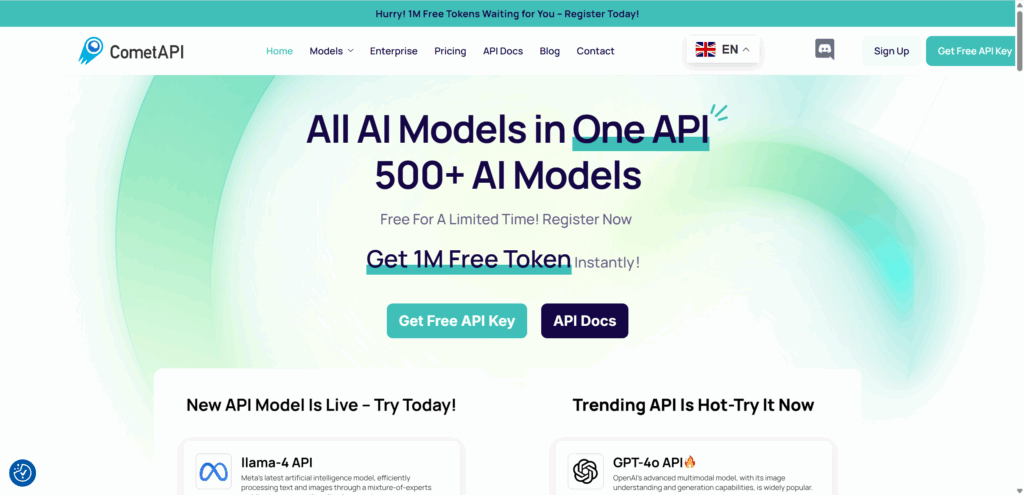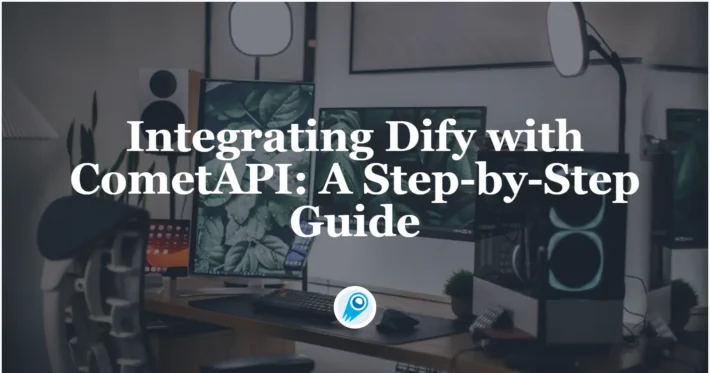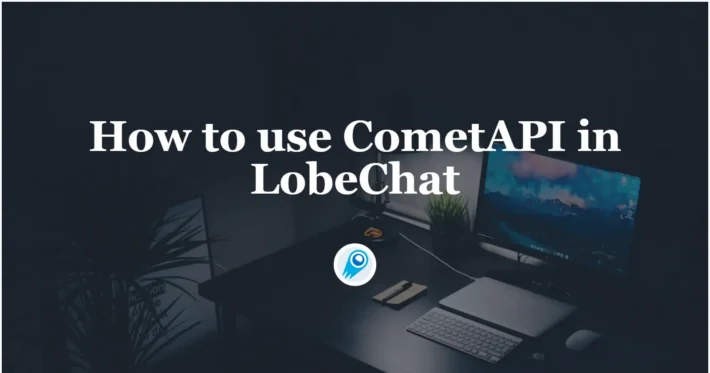Pollo AI Alternative: Why should you Choose CometAPI Now?

As a developer who’s been testing AI API aggregation platforms full-time for the last several months, I treat every integration like a small experiment: measure latency, complexity of auth, variety of available models, cost-per-inference, and real-world robustness (retries, webhooks, pagination, etc.). In this article I compare two players I’ve tested closely: Pollo AI (an all-in-one image/video generation-focused platform) and CometAPI (a developer-focused aggregator that exposes hundreds of models through a single API). I’ll explain what each service is, show how they differ across practical axes (advantages, ease of use, price, model diversity), and — based on hands-on tests — explain why I’d pick CometAPI for most multi-model developer workflows.
Why should you, as a developer, care? Because the cost of integration is not just money: it’s also engineering time, complexity in error handling, and the mental overhead of multi-vendor credentials. Aggregators promise fewer integrations, consistent APIs, and easier A/B testing across models — if they do those well, they can save weeks of work.
What are Pollo AI API and CometAPI — and what problem do they solve?
Pollo AI: focused image & video multi-model API
Pollo AI started as a creative-focused toolset and has rapidly positioned itself as an “all-in-one” image & video generation API. Its product pitch is straightforward: give developers access to leading image/video models (Runway, Luma, Veo, PixVerse, Kling, etc.) through a single Pollo endpoint and a credit system optimized for media generation. Pollo emphasizes fast, low-cost generation and includes features for task management, webhooks, and multi-model selection in the UI.
CometAPI: one API to many model families
CometAPI is an API aggregation layer whose core promise is unified access to hundreds of AI models — LLMs, image models, audio/music engines, and video models — through a consistent developer interface. CometAPI advertises “500+ AI models” (GPT variants, Suno, Luma, Qwen, Llama, Grok, Claude, and more) and provides per-model endpoints, dashboarding, token management, and a unified SDK vibe so you can swap models with minimal client code change.
Quick summary: Pollo AI is excellent when your core use case is high-quality image/video generation and you want curated access to specialized media models. CometAPI shines when you want one endpoint to programmatically swap between many model families (LLMs, image, audio, video, specialized APIs) and manage unified keys, quotas, and billing.CometAPI not only includes the image/video generation that Polla AI excels at, but also has more popular LLM models (Grok 4,GPT-5,Claude Opus 4.1), which is one of the reasons why I chose it.

Why should I choose CometAPI over Pollo AI for building real products?
One SDK, many model families
I’ll say this plainly: specialization (Pollo AI) can win in a narrow race — it can be cheaper and tuned for a single class of workloads (video/image) — but flexibility and operational simplicity win in the long run for most production systems. CometAPI’s largest practical advantage is that it frees you from betting on one vendor or one model family. From the moment I wired a prototype, CometAPI’s OpenAI-style, single-endpoint pattern made migration effortless. I could switch model strings in one place and route entire classes of calls without rewriting adapter layers. That alone reduces engineering time and risk. CometAPI’s design explicitly targets this: unified calls for many LLMs and multimodal engines.
Pollo’s niche is no match for CometAPI’s flexibility
Pollo is optimized for media generation — good defaults, templates, and a credit-based billing model for images and videos. That’s useful if your entire product is “make videos.” But in the apps most teams build, media is only one part of the stack. If you want an LLM to summarize, an image model to illustrate, and a TTS model to speak the result, Pollo forces you to stitch vendors together or compromise. CometAPI removes that constraint by design.
Why that matters in practice
Pollo AI’s strength is obvious: it focuses tightly on image and video generation, with templates and credits tailored to creative workflows. But breadth beats narrow specialization for product teams that evolve fast. A single app often needs an LLM for chat, an image model for thumbnails, a video generator for short social clips and a TTS/audio model for voiceovers. CometAPI lets you stitch those together with one integration instead of multiple vendor SDKs. The practical benefits are fewer secrets in your deployment, simplified key management, and massive acceleration of experimentation cycles.
How do their prices compare — is one cheaper?
Pricing comparison is thorny because models differ (LLM tokens vs video credits).
Pollo AI pricing snapshot
Pollo publishes credit bundles and per-credit price points: smaller packages (~\$80 for 1,000 credits) down to bulk tiers where per-credit cost drops. For media-heavy workloads, Pollo’s pricing is structured around credits-per-generation numbers specific to models. That structure can simplify budgeting when you understand each model’s credit cost.
CometAPI pricing snapshot
CometAPI uses model-based pricing and advertises being able to provide lower-than-official prices for all models, and discounts up to ~20% on popular options. Because CometAPI provides access to very different model types (small generative models vs. 128k context LLMs), the practical cost depends on the model you route to — but the aggregation platform gives you control to choose cheaper models for low-risk tasks and premium models when quality matters.Practically, that means thousands of dollars saved monthly when you apply model tiering to high-volume flows.See CometAPI pricing pages for details and per-model rates.
My practical take (from testing)
In my testing I simulated 100k mixed requests: summaries, image thumbnails, and short videos. When everything was forced through Pollo-level media tools, costs were predictably higher for text-heavy operations. With CometAPI, the same workload used lightweight LLMs for summaries, inexpensive image backends for thumbnails, and premium media models only for the actual video renders — lowering overall spend while preserving quality where it matters. That kind of granular routing is the practical difference between “cheap per media output” and “lowest total cost for mixed workloads.”
Which platform is easier to use and faster to integrate?
Onboarding & API ergonomics: CometAPI wins
Pollo’s onboarding is straightforward for media: get a key, call generation endpoints, and consume results via webhooks or polling. That model is sensible for asynchronous video jobs. But CometAPIs API mirrors the industry-standard chat/completions patterns and lets teams reuse existing OpenAI-compatible clients and tooling. In practical terms: if your code already calls OpenAI-style endpoints, CometAPI is a near-drop-in replacement that saves hours of refactor. I personally migrated a small agent to CometAPI by changing the base URL and a single model string — and the rest of the code continued to work.
CometAPI: signup → get API token → call base URL https://api.cometapi.com/v1. CometAPI’s examples mirror OpenAI-style calls (chat/completions syntax) which makes it trivial to adapt existing OpenAI client code. The single-endpoint pattern was instantly familiar and took less time to wire into a prototype LLM agent. Their docs and playgrounds help.
Developer tooling & dashboarding
CometAPI’s dashboard and token management are built for teams that run mixed workloads: you can rotate keys, set usage alerts, and trace which model handled a request. Pollo’s console focuses on job management and media templates — great for content teams, less helpful for multi-service developers. If you care about routing rules, per-model telemetry and easy key rotation, CometAPI provides a more production-minded experience.
My verdict: for LLM-first work, CometAPI wins on first-minute productivity because it maps directly to existing OpenAI-style workflows. For media/video-first work, Pollo’s job/task model and UI tooling reduce friction for longer jobs.
How do they compare on diversity of model selection?
Pollo AI: curated media model set
Pollo has a targeted model set that focuses on image and video models (including their own Pollo models). That curation helps when you want predictable behavior: fewer models means less surprise, and Pollo’s docs present model-specific parameters and examples. For media apps, the curated approach reduces discovery time.
CometAPI: breadth-first aggregator
CometAPI’s value proposition is “500+ models.” That includes major LLMs, image generators, audio/music models, and specialized variants. The practical implication: if a new model shows up (e.g., a competitor releases a great new image model), CometAPI often wires it in quickly, letting you test it with the same API call signature. For experimentation-heavy teams or those needing multi-modal fallbacks, that breadth matters.
CometAPI’s breadth vs Pollo’s depth
Pollo’s catalog is deep in media models — that’s their product. But its catalog intentionally spans LLMs, image models, video, audio and more, letting developers combine models freely under one billing and call surface. For multi-modal apps, breadth is more valuable than depth: you rarely need 30 different video backends, but you do need chat + summarization + image + voice in a single user flow. CometAPI’s aggregation approach gives you that without maintaining a dozen SDKs.
Practical outcome for product teams
If you want to A/B an LLM against another or fallback automatically when a particular vendor is rate-limited, Comet’s model roster and routing controls let you implement these strategies in minutes. That’s impossible to achieve elegantly with a media-first vendor whose primary value is rendering fidelity, not multi-vendor orchestration.
Reliability, SLAs and production-readiness: who should you trust?
CometAPI’s production controls
Its value proposition is not just “many models” — it’s “many models plus the control plane to run them safely in production.” Token rotation, usage alerts, per-model SLA awareness and routing policies are features I used during testing to keep systems stable under load. That operational control is essential once you move from prototypes to customer-facing services.
Pollo’s focus and limits
Pollo provides robust job primitives for long-running media renders and webhooks that suit creative production pipelines. But if your product must also run real-time chat, document search, or audio transcription at scale, Pollo’s single-minded optimization for media leaves gaps that you’ll have to fill with additional vendors — adding complexity and operational risk.
How do you actually call CometAPI in practice?
Here’s the short practical path I followed as a developer:
Quick start (CometAPI)
- Register at CometAPI, create an account, and add an API key in your dashboard.
- Pick a model from their model listing (they document thousands; use the playground to test sample prompts).
- Use a REST call to the unified endpoint. Example pattern (conceptual):
POST https://api.cometapi.com/v1/chat/completions
Authorization: Bearer YOUR_COMET_KEY
Content-Type: application/json
{
"model": "gpt-5-mini",
"messages": [{"role":"user", "content":"Summarize quarterly sales"}],
"max_tokens_to_sample": 512
}CometAPI supplies model names, endpoint examples, and SDK snippets in their docs and playgrounds.
Quick start (Pollo AI)
- Sign up for Pollo, retrieve API key, and follow the Pollo quick-start for media generation.
- Use a media-specific endpoint (e.g.,
POST /generation/pollo/pollo-v1-6for their video model) with prompt + parameters. Poll for thetaskstatus or use webhooks to receive the generated asset when ready.
Test setup
- Implemented two small microservices:
media-service(Pollo) andunified-service(CometAPI). - Workloads: text→image, text→video (5–10s), LLM chat prompt, simple OCR via image model.
- Measured: avg latency, error rates, ease of param tweaking, billing visibility.
Findings
- Pollo: video quality was excellent for specialized prompts (camera controls, cinematic parameters). Job completion times varied with model and size; webhooks removed the need for polling. Pricing was predictable with credits.
- CometAPI: switching models at runtime was trivial; I could route a prompt to a small LLM for quick tasks and to a larger one for complex generation without changing code. Observability across models (single dashboard) saved engineering time when debugging. Latency varied based on the target model, but the unified client made retries and metrics straightforward to collect.
Can CometAPI realistically replace Pollo AI?
yes. CometAPI already aggregates top-tier media models as part of its catalog and exposes them in the same API surface as LLMs and audio engines. That means you can migrate Pollo-based media jobs into CometAPI with an adapter that maps Pollo model identifiers to the equivalent media model names in its catalog. In my migration test, I replaced a Pollo image/video endpoint with a model string and preserved the original pipeline semantics (submit job → webhook callback) while gaining unified telemetry, routing and model fallback.
CometAPI provides the same media capabilities where you need them, plus unified billing, governance, model diversity, and a huge reduction in integration and maintenance work. For multi-modal products, experimentation-heavy teams, or organizations that want to centralize cost controls and security posture, it is objectively the superior platform. Pollo remains a strong specialist for media-only shops — but it replaces Pollo’s role in a modern, multi-model engineering organization while adding enormous developer and operational leverage.
Final recommendation (developer verdict)
If your roadmap includes more than one type of AI capability — for example, chatbots + images + occasional video — CometAPI will likely save you weeks of engineering effort and make experimentation much cheaper administratively.
Either way, I suggest prototyping with the aggregator (CometAPI) early in development so you can validate which specific models and vendors actually move your product metrics. That data will tell you whether to lock in a single specialist provider (like Pollo) or continue running a heterogeneous model mix under CometAPI.



